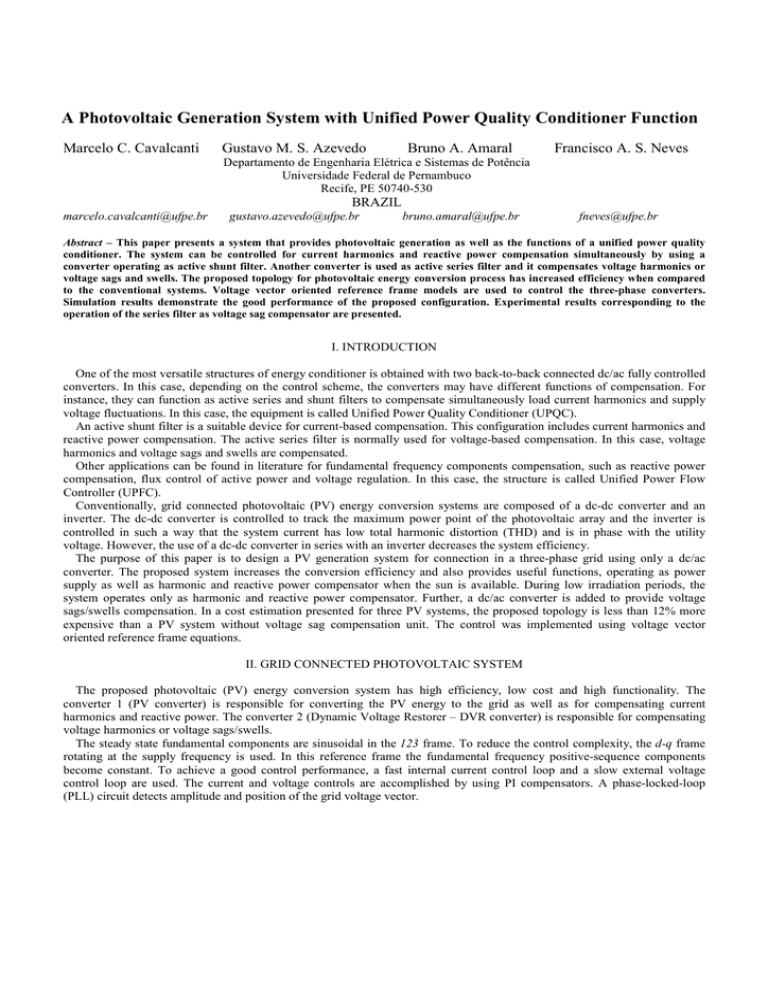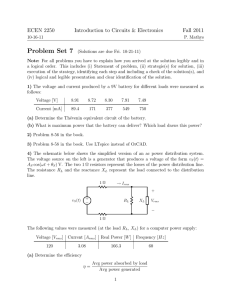A Photovoltaic Generation System with Unified Power Quality
advertisement

A Photovoltaic Generation System with Unified Power Quality Conditioner Function Marcelo C. Cavalcanti Gustavo M. S. Azevedo Bruno A. Amaral Francisco A. S. Neves Departamento de Engenharia Elétrica e Sistemas de Potência Universidade Federal de Pernambuco Recife, PE 50740-530 BRAZIL marcelo.cavalcanti@ufpe.br gustavo.azevedo@ufpe.br bruno.amaral@ufpe.br fneves@ufpe.br Abstract – This paper presents a system that provides photovoltaic generation as well as the functions of a unified power quality conditioner. The system can be controlled for current harmonics and reactive power compensation simultaneously by using a converter operating as active shunt filter. Another converter is used as active series filter and it compensates voltage harmonics or voltage sags and swells. The proposed topology for photovoltaic energy conversion process has increased efficiency when compared to the conventional systems. Voltage vector oriented reference frame models are used to control the three-phase converters. Simulation results demonstrate the good performance of the proposed configuration. Experimental results corresponding to the operation of the series filter as voltage sag compensator are presented. I. INTRODUCTION One of the most versatile structures of energy conditioner is obtained with two back-to-back connected dc/ac fully controlled converters. In this case, depending on the control scheme, the converters may have different functions of compensation. For instance, they can function as active series and shunt filters to compensate simultaneously load current harmonics and supply voltage fluctuations. In this case, the equipment is called Unified Power Quality Conditioner (UPQC). An active shunt filter is a suitable device for current-based compensation. This configuration includes current harmonics and reactive power compensation. The active series filter is normally used for voltage-based compensation. In this case, voltage harmonics and voltage sags and swells are compensated. Other applications can be found in literature for fundamental frequency components compensation, such as reactive power compensation, flux control of active power and voltage regulation. In this case, the structure is called Unified Power Flow Controller (UPFC). Conventionally, grid connected photovoltaic (PV) energy conversion systems are composed of a dc-dc converter and an inverter. The dc-dc converter is controlled to track the maximum power point of the photovoltaic array and the inverter is controlled in such a way that the system current has low total harmonic distortion (THD) and is in phase with the utility voltage. However, the use of a dc-dc converter in series with an inverter decreases the system efficiency. The purpose of this paper is to design a PV generation system for connection in a three-phase grid using only a dc/ac converter. The proposed system increases the conversion efficiency and also provides useful functions, operating as power supply as well as harmonic and reactive power compensator when the sun is available. During low irradiation periods, the system operates only as harmonic and reactive power compensator. Further, a dc/ac converter is added to provide voltage sags/swells compensation. In a cost estimation presented for three PV systems, the proposed topology is less than 12% more expensive than a PV system without voltage sag compensation unit. The control was implemented using voltage vector oriented reference frame equations. II. GRID CONNECTED PHOTOVOLTAIC SYSTEM The proposed photovoltaic (PV) energy conversion system has high efficiency, low cost and high functionality. The converter 1 (PV converter) is responsible for converting the PV energy to the grid as well as for compensating current harmonics and reactive power. The converter 2 (Dynamic Voltage Restorer – DVR converter) is responsible for compensating voltage harmonics or voltage sags/swells. The steady state fundamental components are sinusoidal in the 123 frame. To reduce the control complexity, the d-q frame rotating at the supply frequency is used. In this reference frame the fundamental frequency positive-sequence components become constant. To achieve a good control performance, a fast internal current control loop and a slow external voltage control loop are used. The current and voltage controls are accomplished by using PI compensators. A phase-locked-loop (PLL) circuit detects amplitude and position of the grid voltage vector.



